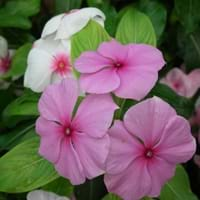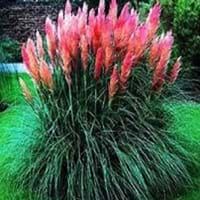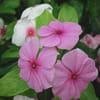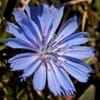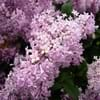Life Span
Perennial
Perennial
Type
Flowering Plants, Shrubs
Grass
Origin
Madagascar
South America, Argentina
Types
Purple vinca, Vinca, cherry red, strawberry color
Not Available
Number of Varieties
Not Available
Habitat
Subtropical climates, Tropical regions
All sorts of environments
USDA Hardiness Zone
4-9
7-11
AHS Heat Zone
12-1
12 - 7
Sunset Zone
A1, A2, A3, H1, H2, 1a, 1b, 2a, 2b, 3a, 3b, 4, 5, 6, 7, 8, 9, 10, 11, 12, 13, 14, 15, 16, 17, 18, 19, 20, 21, 22, 23, 24
H1, 3a, 3b, 4, 5, 6, 7, 8, 9, 10, 11, 12, 13, 14, 15, 16, 17, 18, 19, 20, 21, 22, 23, 24
Habit
Clump-Forming
Arching/Fountain-shaped
Flower Color
Magenta, Pink, Rose
Pink
Flower Color Modifier
Not Available
Bicolor
Fruit Color
Not Available
Non Fruiting Plant
Leaf Color in Spring
Dark Green
Green, Gray Green
Leaf Color in Summer
Dark Green
Light Green
Leaf Color in Fall
Dark Green
Green, Gray Green
Leaf Color in Winter
Dark Green
Green, Gray Green
Leaf Shape
Oval
long with sharp edges
Plant Season
Fall, Spring, Summer, Winter
Spring, Summer, Fall, Winter
Sunlight
Partial shade
Full Sun, Partial Sun, Partial shade
Type of Soil
Loamy, Sandy, Well drained
Loam, Sand
The pH of Soil
Neutral, Slightly Alkaline
Acidic, Neutral, Alkaline
Soil Drainage
Well drained
Well drained
Bloom Time
Fall, Spring, Summer
Early Summer, Summer, Late Summer, Early Fall
Tolerances
Drought, Pollution, Salt
Pollution, Salt, Soil Compaction
Where to Plant?
Container, Ground, Pot
Ground
How to Plant?
Seedlings, Stem Planting, Transplanting
Divison, Seedlings, Transplanting
Plant Maintenance
Medium
Medium
Watering Requirements
Does not require lot of watering, Medium
Do not water excessively, Keep the ground moist but not water-logged
In Summer
Lots of watering
Lots of watering
In Spring
Moderate
Moderate
In Winter
Average Water
Average Water
Soil pH
Neutral, Slightly Alkaline
Acidic, Neutral, Alkaline
Soil Type
Loamy, Sandy, Well drained
Loam, Sand
Soil Drainage Capacity
Well drained
Well drained
Sun Exposure
Partial shade
Full Sun, Partial Sun, Partial shade
Pruning
Prune ocassionally
Prune before Winter, Remove damaged leaves, Remove dead branches, Remove dead leaves
Fertilizers
All-Purpose Liquid Fertilizer
10-10-10 diluted liquid fertilizer, All-Purpose Liquid Fertilizer
Pests and Diseases
Botrytis Blight, Canker, Crown rot, Pythium rot, Root rot
Free of serious pests and diseases
Plant Tolerance
Drought
Drought, moderate salt tolerance
Flower Petal Number
Single
Single
Foliage Texture
Medium
Fine
Foliage Sheen
Glossy
Matte
Invasive
Sometimes
Sometimes
Attracts
Butterflies
Birds, songbirds, Wildlife
Allergy
Intestinal gas, Nausea, Vomiting
sneezing
Aesthetic Uses
Beautification, Showy Purposes
Beautification, Informal Hedge, Mixed Border, Ornamental use, Showy Purposes
Beauty Benefits
Not Available
Not Available
Environmental Uses
Air purification
Air purification
Medicinal Uses
Chest pain, High blood pressure, Inflammation, Sore throat, Tooth ache, Wounds
No Medicinal Use
Part of Plant Used
Whole plant
Flowering Tips, Stem, Whole plant
Other Uses
Decoration Purposes, Showy Purposes, Used as Ornamental plant
Showy Purposes
Used As Indoor Plant
Yes
Sometimes
Used As Outdoor Plant
Yes
Yes
Garden Design
Bedding Plant, Container, Edging
Dried Flower/Everlasting, Feature Plant, Foundation, Hedges, Screening / Wind Break
Botanical Name
Catharanthus roseus
CORTADERIA selloana 'Carminea Rendatleri'
Common Name
Madagascar periwinkle or rosy periwinkle
Pampas Grass, Pink Pampas Grass
In Hindi
Periwinkle
Pink Pampas grass
In German
Immergrün
Pink Pampas grass
In French
Pervenche
Herbe Pampas rose
In Spanish
Bígaro
Hierba de color rosa Pampas
In Greek
μυρτιά
Pink Pampas grass
In Portuguese
Mirta
Grama de Pampas rosa
In Polish
Barwinek
Różowy Pampas trawy
In Latin
Periwinkle
Pink Pampas grass
Phylum
Mollusca
Tracheobionta
Class
Gastropoda
Liliopsida
Order
Geraniales
Cyperales
Family
Apocynaceae
Poaceae
Genus
Catharanthus
Cortaderia
Clade
Not Available
Not Available
Tribe
Not Available
Not Available
Subfamily
Not Available
Not Available
Number of Species
Not Available
Importance of Periwinkle and Pink Pampas Grass
Want to have the most appropriate plant for your garden? You might want to know the importance of Periwinkle and Pink Pampas Grass. Basically, these two plants vary in many aspects. Compare Periwinkle and Pink Pampas Grass as they differ in many characteristics such as their life, care, benefits, facts, etc. Every gardener must at least have the slightest clue about the plants he wants to plant in his garden. Compare their benefits, which differ in many ways like facts and uses. The medicinal use of Periwinkle is Chest pain, High blood pressure, Inflammation, Sore throat, Tooth ache and Wounds whereas of Pink Pampas Grass is No Medicinal Use. Periwinkle has beauty benefits as follows: Not Available while Pink Pampas Grass has beauty benefits as follows: Not Available.
Compare Facts of Periwinkle vs Pink Pampas Grass
How to choose the best garden plant for your garden depending upon its facts? Here garden plant comparison will help you to solve this query. Compare the facts of Periwinkle vs Pink Pampas Grass and know which one to choose. As garden plants have benefits and other uses, allergy is also a major drawback of plants for some people. Allergic reactions of Periwinkle are Intestinal gas, Nausea and Vomiting whereas of Pink Pampas Grass have sneezing respectively. Having a fruit bearing plant in your garden can be a plus point of your garden. Periwinkle has no showy fruits and Pink Pampas Grass has showy fruits. Also Periwinkle is flowering and Pink Pampas Grass is not flowering . You can compare Periwinkle and Pink Pampas Grass facts and facts of other plants too.
